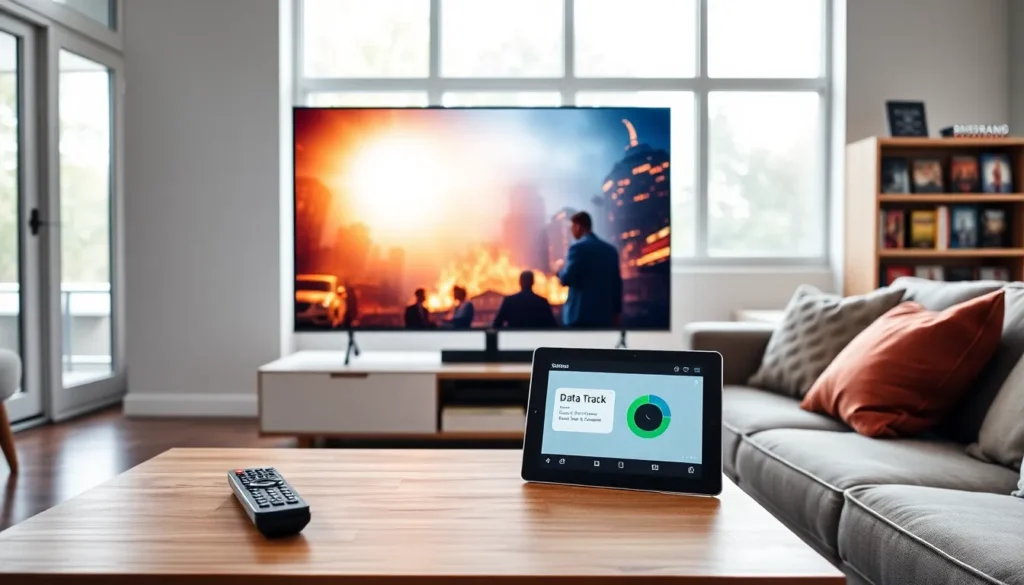Streaming TV has revolutionized how we consume media, replacing the good old days of flipping through channels and hoping for something decent to watch. But there’s a nagging question lurking in the background: how much data does streaming TV actually use? If you’re anything like most viewers, you’ve probably felt the sting of a hefty data bill after a binge-watching spree. Fear not. In this guide, we’ll peel back the curtain on streaming data consumption, ensuring you remain the Netflix wizard, rather than a data villain. So grab your remote and settle in for some enlightening insights.
Table of Contents
ToggleUnderstanding Data Usage in Streaming

Streaming TV uses data in a way that’s a bit like ordering takeout. You don’t realize it at the time, but it all adds up. To break it down, streaming services deliver content via the internet, requiring data to play those beloved movies and shows. When you stream video online, your device sends and receives data packets, which allow you to watch content seamlessly. On average, streaming services consume anywhere from 0.5 to 7 GB of data per hour, depending on several factors, which we will explore further.
Even though these numbers, each person’s data usage can vary widely based on their habits and streaming choices. If you’re a casual viewer who watches an occasional episode, you might not notice the data drain. But, for die-hard binge-watchers, those numbers can ramp up fast.
Factors Affecting Data Consumption
Numerous elements influence how much data streaming TV gobbles up. Here are some key players in the data game:
- Resolution and Quality: Higher quality presentations require more data. Watching your favorite show in 4K? Prepare for a bigger bite out of your data allowance compared to 720p.
- Streaming Service Used: Different platforms have unique compression algorithms, resulting in varying data consumption rates. Some services may optimize better than others for data usage.
- Length of Viewing: It’s simple math. The more you watch, the more data you use.
- Network Stability: A stable connection allows for efficient streaming, while poor networks can lead to buffering, which sometimes causes more data to be consumed as the service attempts to maintain quality.
- Multiple Streams: If multiple devices are streaming simultaneously, data usage skyrockets. Sharing a family plan with others? Prepare to share those data bills.
Data Usage by Streaming Quality
When it comes to streaming quality, it’s essential to understand how different resolutions impact your data usage. Below is a quick guide that illustrates just how much data you might use:
- Standard Definition (SD): Streaming in SD typically uses about 1 GB of data per hour. This is a great option if you don’t mind sacrificing a little quality.
- High Definition (HD): Expect consumption around 3 GB per hour for HD quality. This is where most viewers land, offering a nice balance of quality and data use.
- Ultra High Definition (4K): For the top-tier experience, 4K can consume an impressive 7 GB or more per hour. Perfect for movie nights, or for blowing your data limits to smithereens.
To put this in perspective, if you decided to binge-watch a full season of a 10-episode series in 4K, that could cost you roughly 70 GB of data. That’s the equivalent of downloading an HD movie or two.
Estimating Data Use for Different Streaming Platforms
Estimating data usage is crucial, especially when choosing between streaming platforms. Here’s a rough overview of popular streaming services and their expected data consumption:
- Netflix:
- SD: ~1 GB/hour
- HD: ~3 GB/hour
- 4K: ~7 GB/hour
- YouTube:
- SD: ~0.5 GB/hour
- HD: ~1.5 GB/hour
- 4K: ~4-5 GB/hour
- Hulu:
- SD: ~1 GB/hour
- HD: ~3 GB/hour
- No 4K option
- Amazon Prime Video:
- SD: ~0.9 GB/hour
- HD: ~2.5 GB/hour
- 4K: ~6-7 GB/hour
By knowing these averages, viewers can make informed decisions. It helps to plan viewing habits according to data caps, ensuring frustration-free streaming.
Tips for Managing Data Usage While Streaming
Now that we’ve laid the groundwork for understanding streaming data usage, here are some practical strategies to manage it:
- Adjust Streaming Quality Settings: Most streaming services allow users to select their preferred quality. Reducing to SD or HD can save on data.
- Download Content: Some platforms offer offline viewing, which can be a lifesaver. Download your favorite episodes when connected to Wi-Fi, then watch whenever you want without using more data.
- Monitor Your Data Plan: Keep an eye on your data cap. Many providers offer apps to track data consumption. Staying aware can help avoid any unpleasant surprises.
- Limit Multiple Streams: If sharing with family or roommates, coordinate viewing times. This way, the collective data use is lowered.
- Invest in Unlimited Data Plans: When all else fails, consider an unlimited data plan. It might save those tense moments when the data bill arrives.








